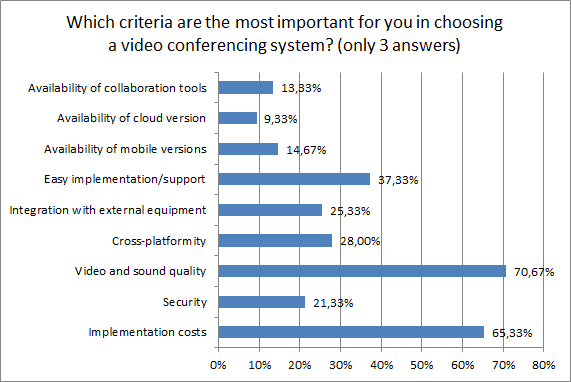2014 Video Conferencing Market Forecasts from TrueConf
 In 2014, the market share of software solutions and the popularity of video conferencing technology will continue to grow rapidly. Integrators will face challenges in selling cloud video conferencing solutions, and users will require more access to video conferencing from mobile devices.
In 2014, the market share of software solutions and the popularity of video conferencing technology will continue to grow rapidly. Integrators will face challenges in selling cloud video conferencing solutions, and users will require more access to video conferencing from mobile devices.
The “software revolution” of 2013 was the major catalyst for change within the video conferencing industry, with all major video conferencing manufacturers shifting their priorities and moving from focusing on specialized hardware to focusing on systems software solutions. Many new players have also recently entered the market, bringing new approaches to the implementations of video conferencing systems. This has created serious competition, but has also promised many desirable and useful features for users.
There are many trends on the market, but which of them are winners? What deserves attention, and what is best ignored? We will try to understand some of them here.
The Growth of Cloud-Based Solutions
The hottest issue at the moment may well be the competition between cloud-based and dedicated solutions for video communication.
Leading manufacturers of hardware solutions are in no hurry to raise the capacity of MCUs and thus lower the cost of their “ports”, referring to the backward compatibility with older terminals and other vendors’ systems. Companies often claim that their product is 100% software and supports SVC (Scalable Video Coding), but in fact, SVC is just one of the codecs in their solution and video conferencing will still require additional hardware.
These vendors are in a considerably weaker position than the ability of new players in the market, who can offer to eliminate CAPEX spent on video conferencing by providing MCU capacities from the cloud or deploying them on virtual machines at substantially lower prices.

As a consequence, the high demand for cloud-based video conferencing or VaaS (video conferencing as a service)/UCaaS (Unified Communications as a Service) solutions will be a very painful transition for many integrators and partners who have gotten used to reselling “products”, not service-based solutions.
Cloud approaches allow manufacturers to abandon their partner channels and sell these systems directly, but the complexity of implementation yet hinders this process. As a result, the pursuit for balance between the desire to sell their cloud product directly, and the desire to maintain existing partnerships result in difficulties in the relationships between manufacturers and their partners and integrators, but might result in a nice bonus for users.
One more popular concern regarding cloud video conferencing solutions is security. According to the annual industry study conducted by TrueConf on their traditional Video+Conference seminar, 21 percent of consumers believe that security is a top criteria for selecting a video conferencing system.

Therefore, in 2014 we will have to get used to implementing two-factor authentication, traffic encryption, protection of connections, regular change of passwords and implementation of mechanisms to protect mobile devices.
The Future of WebRTC Technology
Leading manufacturers of video conferencing solutions will continue to work their way towards integrating WebRTC technology, which gained a great deal of interest in 2013. This is a very promising and popular technology, but complete solutions based on WebRTC are only just beginning to emerge and video quality remains at its weakest point. It is still too early to talk about widespread use of WebRTC and its application in meeting rooms at the time of this report.
TrueConf Technical Director Stas Soldatov says: “There is a chance that WebRTC will not become popular if Apple or Microsoft will not support it. In addition, not all manufacturers have SVC in their solutions and not all video conferencing solutions support the WebRTC-native VP8 codec. This slows growth and reduces the amount of WebRTC-capable offerings on the market. Although we have already made SVC for our WebRTC a long time ago.”
The Future of Standards
The wide range of offerings from different manufacturers complicates the process of communication between consumers. The majority of solutions are directly incompatible with each other, especially the software with the hardware, so to organize the sharing session between meeting rooms or video conferencing terminals in different companies without using the gateway is getting harder each day. This situation may lead to several outcomes:
- Optimistic: The manufacturers will support a uniform standard for modern scalable video codec (SVC) in hardware solutions. It will support fixed dialing (standardized), H.323/SIP protocols extensions regarding, for example, statuses and content sharing. However, for now each company has its own vision on how coding and sharing should be done if dealing not only with sound and video.
- Realistic: Quick and easy connection of external subscribers through mobile or web applications (e.g. WebRTC). Alas, this option is not suitable for meeting rooms until there is standard support of the H.264 codec in WebRTC.
According to TrueConf, new H.265/VP9 video codec-based solutions will not reach top popularity as long as video conferencing terminals – which, as we know, manufacturers are trying to build based on conventional PCs – are not created with sufficiently powerful processors. In general, the situation depends on new breakthroughs of Intel, and we can’t forget that Moore’s Law is always in effect.
Another reason for the delay in transition to new codecs will be the appearance of 4K video conferencing systems. And, at the moment, only manufacturers of software systems can offer such quality. Architecture of hardware systems which are built on the principle of one stream per input, one stream per output simply can not transcode such high resolution images in real time using multipoint conference servers (MCU) on the terminal, even if the terminal itself is able to “digest” such loads.
Conclusion
In general, this year will be interesting and full of new technologies and challenges. Manufacturers will have to work even harder due to the recent changes in the market, but people looking for video conferencing solutions will be granted with an increase in supply and possible decline in prices.
Michael Gotalsky, TrueConf CCO, is prepared to meet the challenge: “With our innovative solutions, we are ready to answer any inquiries of the market, whether it is for high-level security, support of 4K video conferencing, mobility or WebRTC.”



Follow us on social networks